Thursday, December 3, 2009
Glass Block exhibit
I have a photo exhibit! It's a small compendium of Sculptured Glass Module photographs (such as those seen here.) Curated by Serhii Chrucky of Forgotten Chicago, it's on display this week only through December 6th, at University of Illinois Chicago. 5th Floor, Art & Design Hall. 400 S. Peoria. I'm eager to see it myself!
Tuesday, October 27, 2009
Fall comes to the North Shore
Fall leaves from Sheridan Road and elsewhere along Lake Michigan's northern shore.


The North Shore, from Evanston on up to Winnetka, is an unbelievable assemblage of wealth. Mansion after mansion lines Sheridan Road as it winds its way up the lake. Compared to the urban hustle of Chicago just a few miles south, the area is unbelievably sylvan and tranquil.



The houses are pretty unbelievable, and there's quite a few of architectural interest, but for now, let's just enjoy the pretty colors, shall we?





The North Shore, from Evanston on up to Winnetka, is an unbelievable assemblage of wealth. Mansion after mansion lines Sheridan Road as it winds its way up the lake. Compared to the urban hustle of Chicago just a few miles south, the area is unbelievably sylvan and tranquil.



The houses are pretty unbelievable, and there's quite a few of architectural interest, but for now, let's just enjoy the pretty colors, shall we?



Labels:
Life in Chicago,
North Shore
Thursday, October 22, 2009
Unable to get its way, Chicago smashes all its toys and goes home
The Gropius in Chicago Coalition reports that Chicago has finally acknowledged Walter Gropius's role in designing the Michael Reese campus, and has therefore decided to save... one building.
Yeah.
I still don't get it. Did all those fancy words during the Olympic bid about Chicago's great cultural heritage mean nothing?
Yeah.
I still don't get it. Did all those fancy words during the Olympic bid about Chicago's great cultural heritage mean nothing?
Sunday, October 18, 2009
3550 Lake Shore Drive
If you drive down LSD enough at night, you've seen this striking MidCentury lobby.
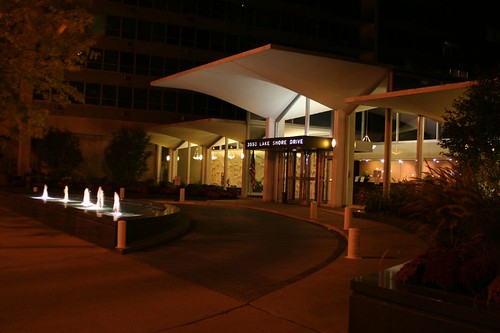
It joins two massive 1962 apartment towers at 3550 Lake Shore Drive. Though the folded plate roof is modestly interesting, it wouldn't be enough to make the lobby a real show stopper. What does the trick is the abstract sculpture running the length of the lobby.
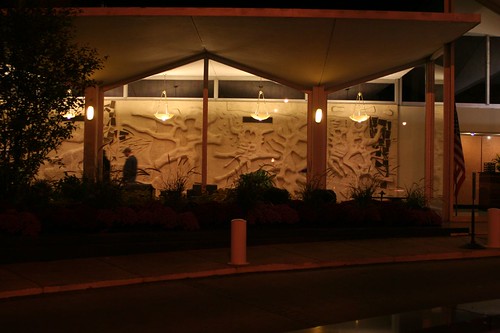
Clearly visible from the rushing highway, the work is by prolific sculptor Abbott Pattison. Its abstract shapes transform what would otherwise be a plain glass and stone lobby into a quintessentially 1960s mode of expression, and a highlight to be watched for as one flies down LSD.

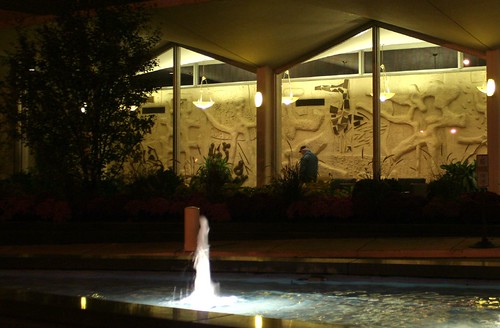

It joins two massive 1962 apartment towers at 3550 Lake Shore Drive. Though the folded plate roof is modestly interesting, it wouldn't be enough to make the lobby a real show stopper. What does the trick is the abstract sculpture running the length of the lobby.

Clearly visible from the rushing highway, the work is by prolific sculptor Abbott Pattison. Its abstract shapes transform what would otherwise be a plain glass and stone lobby into a quintessentially 1960s mode of expression, and a highlight to be watched for as one flies down LSD.


Wednesday, October 14, 2009
Chi-(na)town
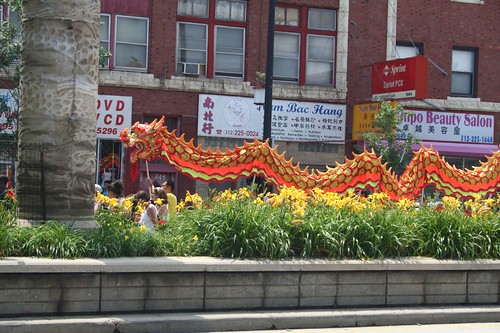
Chicago's Chinatown is an awkwardly formed place. It can be difficult to find, for one thing. And once there, it's easy to visit and come away thinking that the whole of it is contained on its main street, Wentworth Avenue. Certainly, it has most of the showstopper/predictably Chinese-styled architecture:
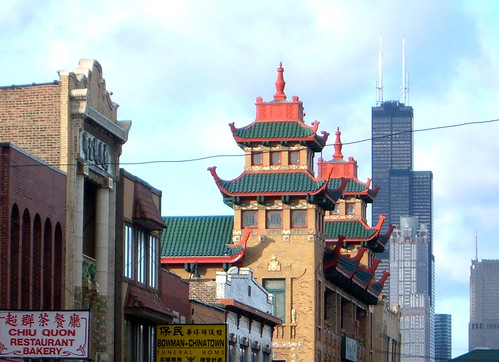
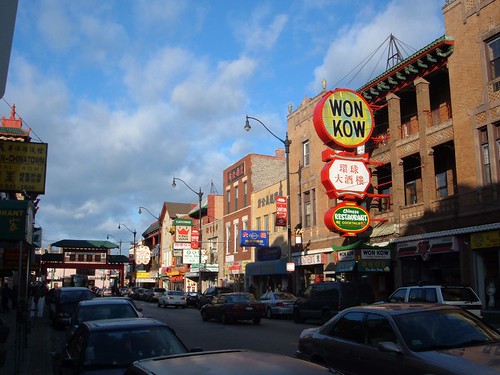
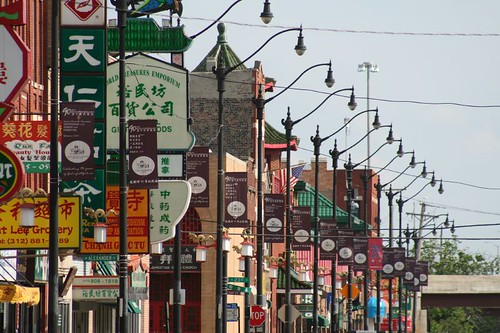
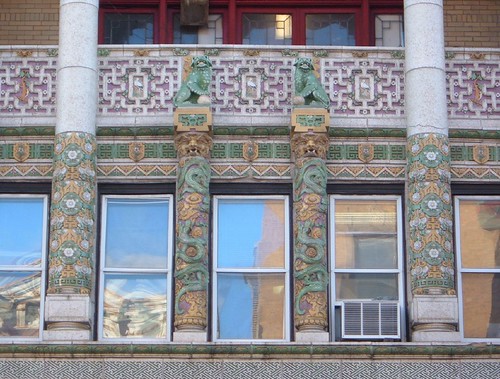
There's a lot more to the area geographically, though. West of Wentworth, a fairly typical older Chicago neighborhood is all that's left of the original streets of the area, severely hacked away by several surrounding freeways. Architecturally, it's of little note, but pleasant enough.
Chinatown's business district spills out along Cermak as well, though the street's large size and busy traffic make it intimidating to cross and essentially make these blocks isolated and inert compared to bustling Wentworth.
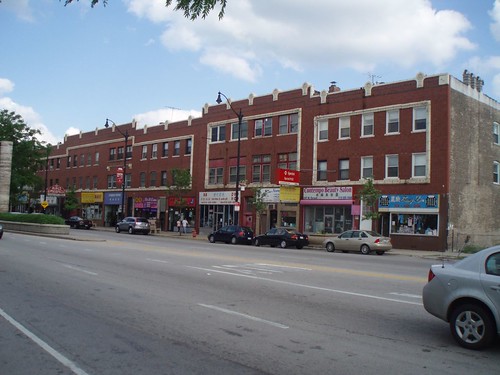
North of Cermak, a strangely underdeveloped triangle of land framed by Archer, Wentworth and Cermak is even more isolated, despite being a necessary bridge between Wentworth and the nearby Chinatown Square mall.
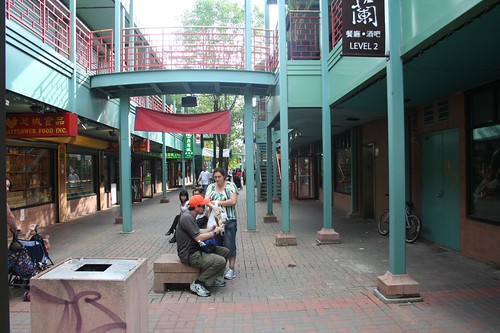
The mall is a recent development, dating back to the 1980s. It thrives despite a somewhat fortress-like attitude toward its neighborhood. It seems to offer virtually no connection to the adjacent streets, but a large central plaza -- maybe too large -- invites visitors to cross Archer and come explore. And once you're in, it's a small city of its own, filled with bustling restaurants and shops of every stripe.
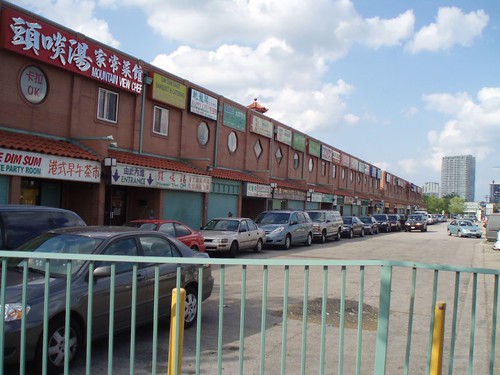



An entire new neighborhood has risen north of Archer in recent years, on former railroad territory. Of course, it wouldn't be Chicago if it didn't involve marching ranks of nigh-identical buildings, but there are some interesting and pleasant spaces among them, and the decorative tastes of the owners leaves no doubt as to what part of town you're in.
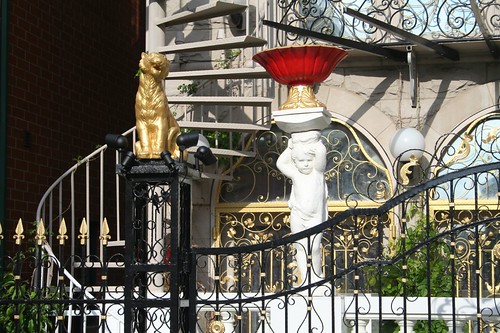

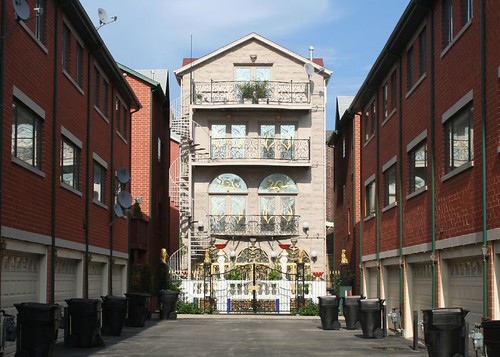
And finally, there's the lovely Ping Tom Memorial Park along the river. Surrounded by active and busy railroads on three sides (including one that regularly cuts off the only route in and out of the park), it's not exactly a perfect oasis, but it has lovely views of the South Branch and the downtown skyline in the distance, and its winding paths are almost long enough to get away from it all.
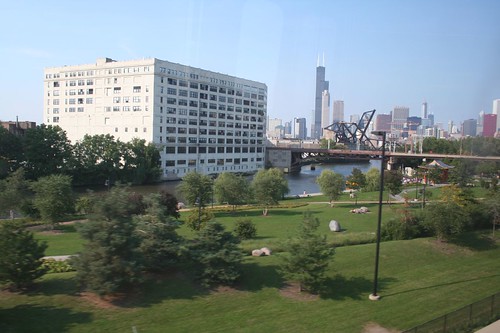
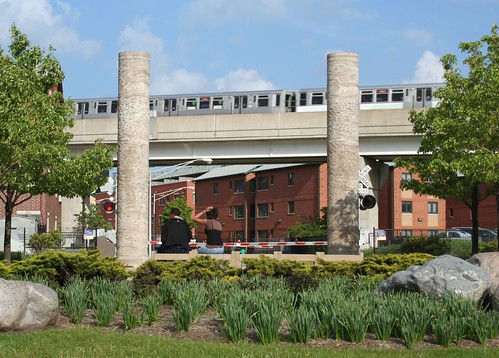
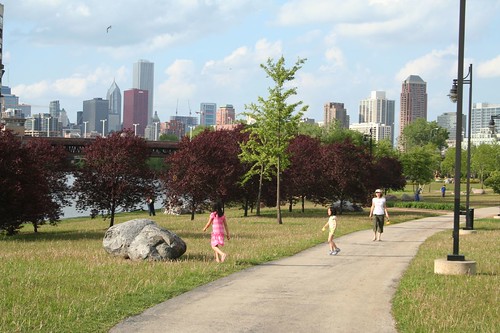
These photos and more can be seen large at my Flickr space.
Monday, October 12, 2009
St. Gertrude Church
St. Gertrude (9613 Schiller Boulevard, Franklin Park, west side) isn't all that striking from the outside. It has bold massing and a strange hipped A-frame structure that makes it resemble a giant tent, but everything on the outside essentially exists to service the spaces inside.
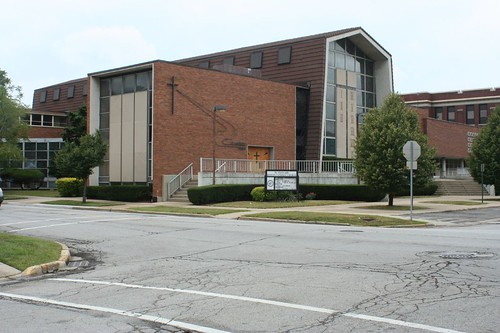
And what spaces they are!
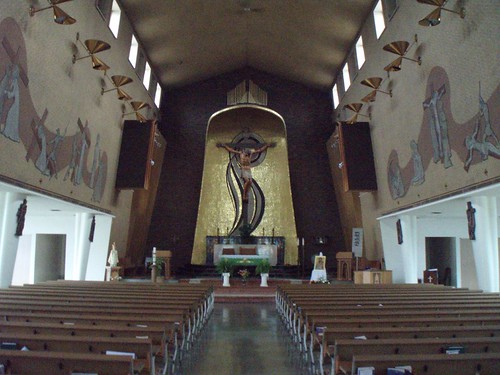
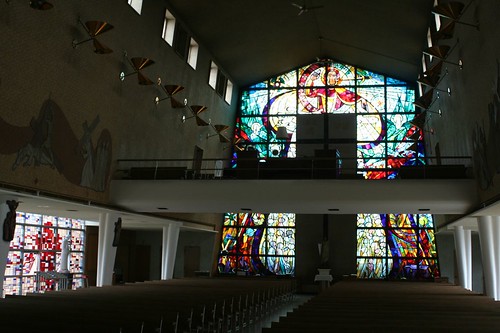
With its Flagrantly Fifties styling and decor, St. Gertrude has become one of my favorite local churches.
It's not just decorative flash, either. The architects pull a pretty slick little trick with the side aisles. Though the walls are a solid mass descending from the ceiling, they suddenly stop about ten feet from the floor, leaving only slender tapered columns to hold up the towering height above. The openings allow the floor space to expand outward, where a solid wall of stained glass creates a beautiful space.
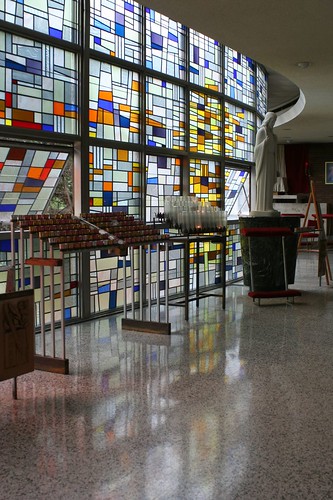
Because so much visual and actual weight is crushing down on those columns, you kind of expect something similar to be happening with the side aisles. I stared at that stained glass side wall for a very long time, trying to figure out what held up the roof. Turns out the thicker window mullions are structural -- there's nothing above the ceiling, and no other columns anywhere.
As if that wasn't enough, the balcony floats freely across the sanctuary, a bridge supported only at its ends, as seen in the sanctuary view at top.

The lovely stained glass was designed by Peter Recker for Conrad Schmit Studio. A cavalcade of Judgement Day images cascades down the rear wall of the sanctuary (and you can tell Recker is fighting against that grid of window mullions -- look how Jesus's head is located just off-center), but it's the sidewalls that I love best, where light is filtered through a dazzling array of abstract color patterns.
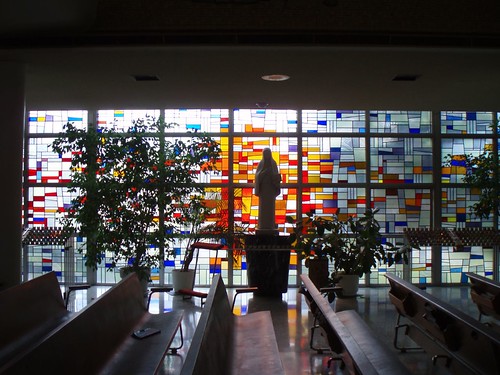
Recker also did the Stations of the Cross.
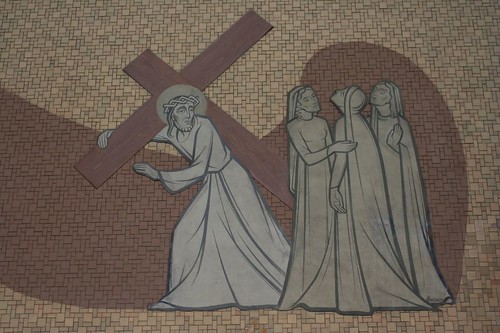

The curved wall behind the crucifix bears a startling resemblance to the focal point in the chapel of St. Joseph Hospital, and sure enough, it's by the same architecture firm, Belli & Belli, who were responsible for a lot of the most awesomely crazy Modernist buildings in Chicago and its suburbs.
Plenty of spaces beyond the sanctuary offer interest as well. The protruding wings contain foyer space and stairwells to the balcony. The stairs are floating masses of terrazzo, with stylized railings, rising alongside a wall flecked with a grid of small window openings. Elaborately worked iron gates stand nearby as well.

The east wing contains the only real aberration in the building; a bathroom has been rather clumsily and awkwardly shoehorned into the end of the wing, complete with a false ceiling that one can look down on from the stairs. On the balance, it's a minor complaint, though.
I love a lot of church buildings, but this is one of the few that keeps me going back again just to absorb its spaces and soak in its architectural glory.

And what spaces they are!


With its Flagrantly Fifties styling and decor, St. Gertrude has become one of my favorite local churches.
It's not just decorative flash, either. The architects pull a pretty slick little trick with the side aisles. Though the walls are a solid mass descending from the ceiling, they suddenly stop about ten feet from the floor, leaving only slender tapered columns to hold up the towering height above. The openings allow the floor space to expand outward, where a solid wall of stained glass creates a beautiful space.

Because so much visual and actual weight is crushing down on those columns, you kind of expect something similar to be happening with the side aisles. I stared at that stained glass side wall for a very long time, trying to figure out what held up the roof. Turns out the thicker window mullions are structural -- there's nothing above the ceiling, and no other columns anywhere.
As if that wasn't enough, the balcony floats freely across the sanctuary, a bridge supported only at its ends, as seen in the sanctuary view at top.

The lovely stained glass was designed by Peter Recker for Conrad Schmit Studio. A cavalcade of Judgement Day images cascades down the rear wall of the sanctuary (and you can tell Recker is fighting against that grid of window mullions -- look how Jesus's head is located just off-center), but it's the sidewalls that I love best, where light is filtered through a dazzling array of abstract color patterns.

Recker also did the Stations of the Cross.


The curved wall behind the crucifix bears a startling resemblance to the focal point in the chapel of St. Joseph Hospital, and sure enough, it's by the same architecture firm, Belli & Belli, who were responsible for a lot of the most awesomely crazy Modernist buildings in Chicago and its suburbs.
Plenty of spaces beyond the sanctuary offer interest as well. The protruding wings contain foyer space and stairwells to the balcony. The stairs are floating masses of terrazzo, with stylized railings, rising alongside a wall flecked with a grid of small window openings. Elaborately worked iron gates stand nearby as well.

The east wing contains the only real aberration in the building; a bathroom has been rather clumsily and awkwardly shoehorned into the end of the wing, complete with a false ceiling that one can look down on from the stairs. On the balance, it's a minor complaint, though.
I love a lot of church buildings, but this is one of the few that keeps me going back again just to absorb its spaces and soak in its architectural glory.
Saturday, October 10, 2009
Empty Midcentury on Broadway
Piser Weinstein Menorah Chapel, 5206 N. Broadway, aka Furth Chapels
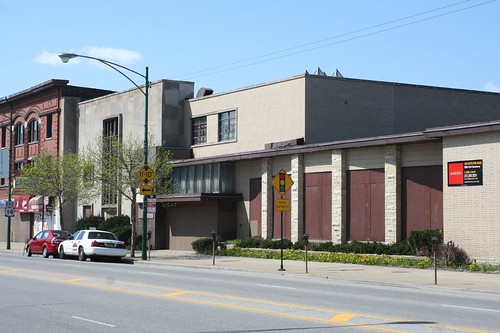
It's not a dazzling building, but its jumble of massing is intriguing. Each function of the building seems to have its own articulation, even its own facade material. And it's hard to fully judge a Modernist building when the windows are boarded over.
The funeral home appears to have operated into 2002, before moving to a new location in Skokie. Since then it's been vacant and boarded up, with a developer planning ot turn the land into new residential development.

Given its former use, the odds of this little Midcentury piece surviving are pretty slim. As detailed in an article in Chicago Real Estate Daily, the economic slowdown is the only reason the building is still standing.
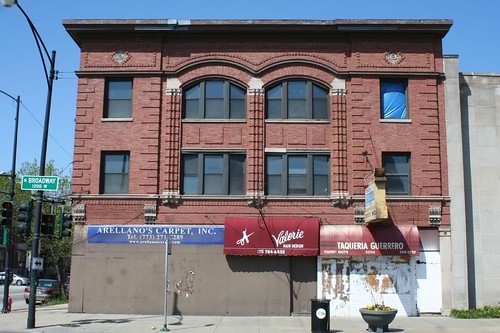
Doomed along with it is this vacant turn of the century apartment house with retail in the base.
I'm sure the would-be developers imagined a massive apartment/condo blockbuster building, similar to others that have gone up along other sections of Broadway in recent years. But with the scent of the money trail gone cold, couldn't some thought be given to finding a new use for this little slice of 1960s style? Much of the lot is empty land. A small outbuilding is the only structure on the northern half of this large city lot -- plenty of room for new and old to co-exist.

It's not a dazzling building, but its jumble of massing is intriguing. Each function of the building seems to have its own articulation, even its own facade material. And it's hard to fully judge a Modernist building when the windows are boarded over.
The funeral home appears to have operated into 2002, before moving to a new location in Skokie. Since then it's been vacant and boarded up, with a developer planning ot turn the land into new residential development.

Given its former use, the odds of this little Midcentury piece surviving are pretty slim. As detailed in an article in Chicago Real Estate Daily, the economic slowdown is the only reason the building is still standing.

Doomed along with it is this vacant turn of the century apartment house with retail in the base.
I'm sure the would-be developers imagined a massive apartment/condo blockbuster building, similar to others that have gone up along other sections of Broadway in recent years. But with the scent of the money trail gone cold, couldn't some thought be given to finding a new use for this little slice of 1960s style? Much of the lot is empty land. A small outbuilding is the only structure on the northern half of this large city lot -- plenty of room for new and old to co-exist.
Tuesday, September 29, 2009
Queen of Heaven Mausoleum
As much as I love historicist styles, at some point, it becomes clear the jig is up and it's time to move on.
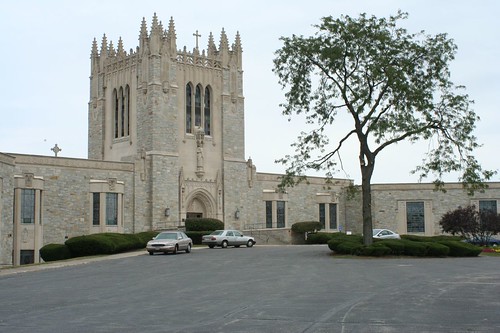
Here, for example, we have Queen of Heaven Mausoleum, begun in 1956, and first opened in spring of 1957. It's a French Gothic styled building. Well, French Gothic Revival. Okay, Neo-French Gothic Revival, since Gothic had already been "revived" as an architectural style about a hundred years earlier. When it was built, World War II was 11 years in the past, televisions were becoming widespread, and Sputnik and the Interstate Highway would be coming down the pike very shortly. Art Deco and Streamline had already come and mostly gone.
I mean, really. Who was building French castles in 1956?
So I wasn't expecting much when I ventured inside the place on a recent Sunday afternoon. Faux Gothic archways would surely get old after a little while, right?
Probably so, but that's not what I found.
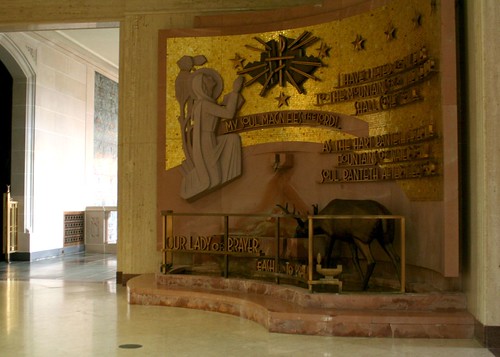
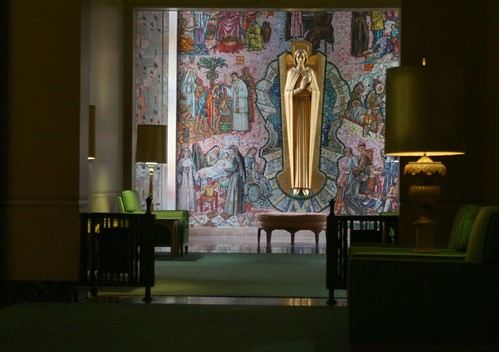
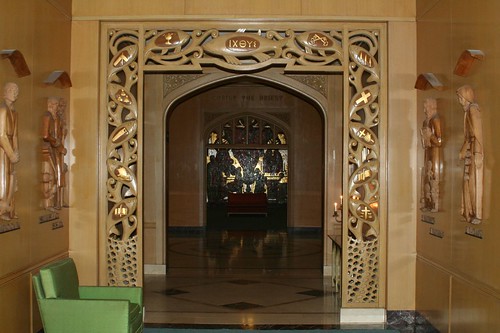

Inside its historicist shell, Queen of Heaven contains a cross-section of contemporary artistic thought circa 1960, and it is glorious indeed. 35 different kinds of marble are used in the interior finishes, and its corridors are lined with a dazzling array of contemporary religious art and iconography. Stained glass, metalwork, wood carving, stone sculpture, paintings, and mosaic tile are integrated throughout the building. No one style dominates, but nearly all of it is touched by the stylized trends of the 1950s.

And there is a ton of it. Queen of Heaven, built in three stages from 1956 through 1964, is the largest Catholic mausoleum in the world, and it is vast. One contemporary account puts the three floors of corridors at over a mile in total length, and it's not hard to believe.
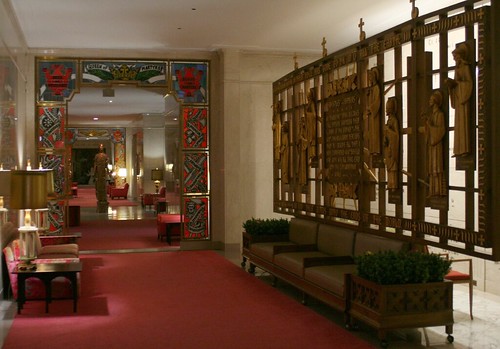
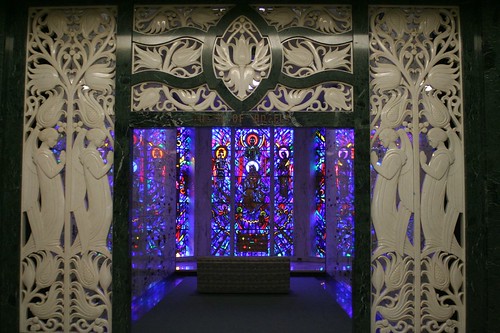
Much of the artwork (if not all) may be attached the Studios of Daprato Statuary Company, with offices in New York and Chicago. Daprato Studios ran an ad in the Chicago Tribune in 1961, proudly proclaiming their role in the vast undertaking. The Archdiocese also advertised the new facility on the same day. Later paintings were completed by Albert Henselmann and Italo George Botti.
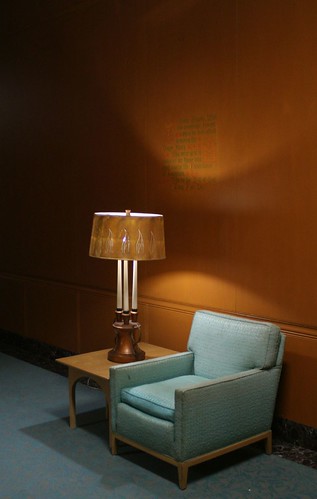
Even the furniture gets in on the act. A series of lamps, mini-couches, armchairs, and end tables cover a miniature spectrum of design ideas. Note the dot-outlined flames on the lampshades above, for example, and the embossed building images on these chairs:
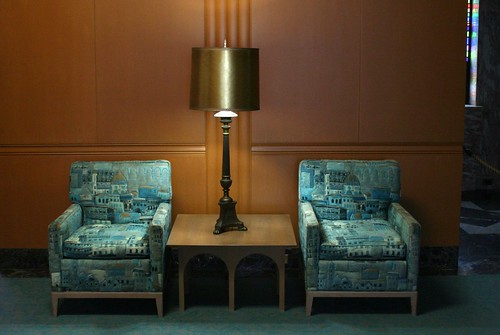
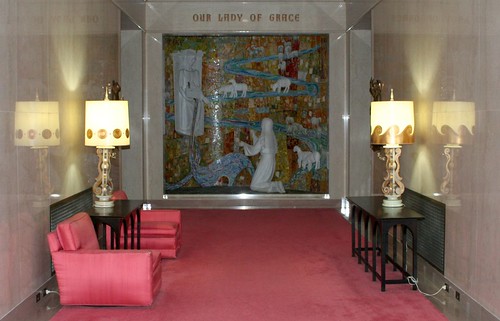
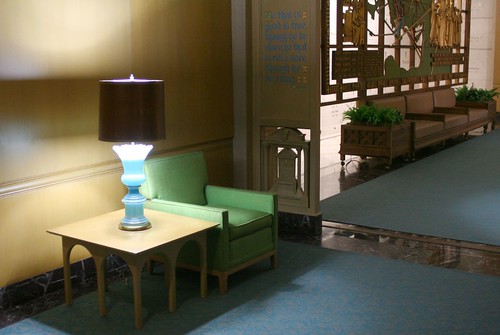
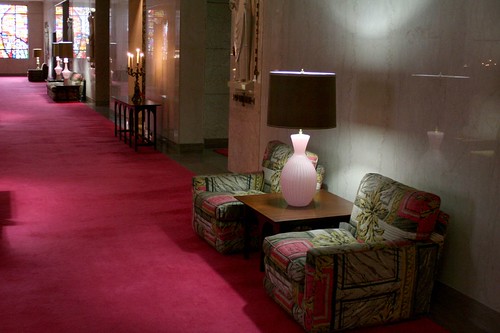
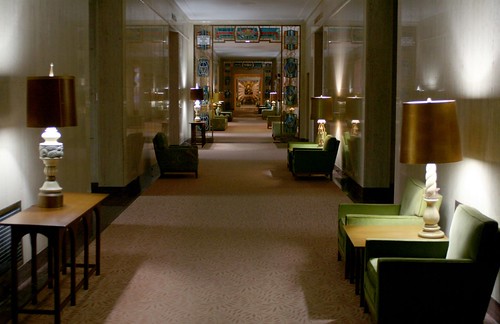
The building itself was designed in stages, with the Gothic central wing and its landmark tower coming first. Nothing in my research attributes the building to a particular firm, but it's a fair bet that Detroit architectural firm Harley, Ellington and Day was responsible, as they did the subsequent west and south wings. The central wing opened in spring of 1957, with room for 7,000 burials, 3 shrines, a main chapel and 4 supplemental chapels. Its $4,000,000 construction cost was covered entirely by advance burial purchases.
The central wing was followed in 1960 by the Queen of Angels wing to the south, designed by Harley, Ellington and Day in a slightly modernized Gothic style (HED was also responsible for the Neo-Formalist Resurrection Mausoleum in nearby Justice, IL.) The large exterior statues on the two side wings were designed by sculptor Ferenc Varga of Detroit, and executed by Gaetano and Alfred Roselli, Italian-born immigrants who worked on the Tribune Tower decades earlier.
A third wing, Queen of All Saints, was designed by recently renamed firm of Harley, Ellington, Cowin & Stirton and completed in 1964, bringing the total capacity of the building to 30,000 interments.
45 years later, it's only 3/4ths full, a testimony to its vast size.
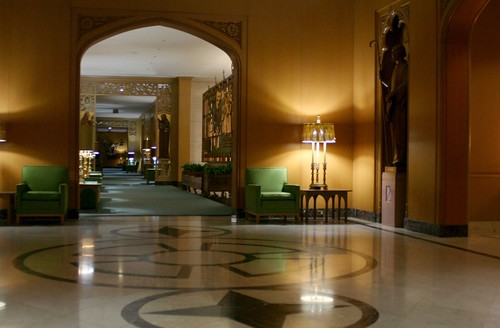
The mausoleum is intended to function as two buildings in one; the dead are contained within their own structure, with its own ventilation system. Despite that, more than a whiff of embalming fluid pervades the air. I spent nearly two hours exploring, and by the time I left I was quite ready to breath fresh air.
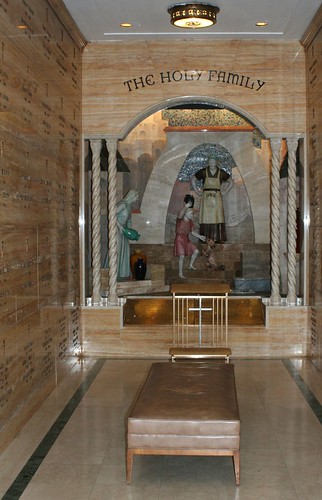
But I left with regret. Queen of Heaven Mausoleum is a treasure trove of Midcentury art and design, some of it among the best and most creative I've seen anywhere. Some of the central pieces, just to cite one example, are these semi-stained glass bas relief sculptures. They appear in key points along the building, such as the main chapel, whose central window looms over the busy intersection of Wolf and Roosevelt. They seem to be executed in a hard painted plastic, with slits, cuts, and notches allowing strategic slits of light through. They are two-sided; the outside of the window gets a fully realized sculpture as well. Unlike many stained glassed designs, there is no front or back to these works. The sculptures are artwork in their own right, even when viewed under full light. In the dim light of the mausoleum, with the daylight streaming through them, they become something else, dark, backlit, haunting, foreboding, and magnificent... like the rest of the mausoleum.
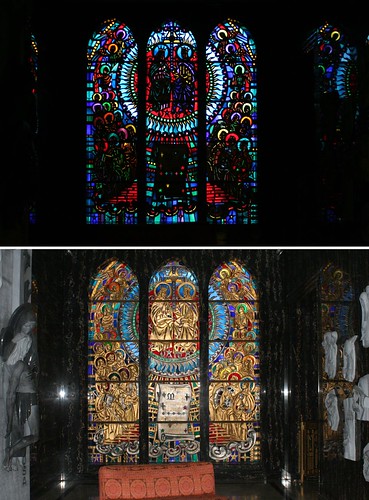
These photos and more may be seen at my Flickr account.

Here, for example, we have Queen of Heaven Mausoleum, begun in 1956, and first opened in spring of 1957. It's a French Gothic styled building. Well, French Gothic Revival. Okay, Neo-French Gothic Revival, since Gothic had already been "revived" as an architectural style about a hundred years earlier. When it was built, World War II was 11 years in the past, televisions were becoming widespread, and Sputnik and the Interstate Highway would be coming down the pike very shortly. Art Deco and Streamline had already come and mostly gone.
I mean, really. Who was building French castles in 1956?
So I wasn't expecting much when I ventured inside the place on a recent Sunday afternoon. Faux Gothic archways would surely get old after a little while, right?
Probably so, but that's not what I found.




Inside its historicist shell, Queen of Heaven contains a cross-section of contemporary artistic thought circa 1960, and it is glorious indeed. 35 different kinds of marble are used in the interior finishes, and its corridors are lined with a dazzling array of contemporary religious art and iconography. Stained glass, metalwork, wood carving, stone sculpture, paintings, and mosaic tile are integrated throughout the building. No one style dominates, but nearly all of it is touched by the stylized trends of the 1950s.

And there is a ton of it. Queen of Heaven, built in three stages from 1956 through 1964, is the largest Catholic mausoleum in the world, and it is vast. One contemporary account puts the three floors of corridors at over a mile in total length, and it's not hard to believe.


Much of the artwork (if not all) may be attached the Studios of Daprato Statuary Company, with offices in New York and Chicago. Daprato Studios ran an ad in the Chicago Tribune in 1961, proudly proclaiming their role in the vast undertaking. The Archdiocese also advertised the new facility on the same day. Later paintings were completed by Albert Henselmann and Italo George Botti.

Even the furniture gets in on the act. A series of lamps, mini-couches, armchairs, and end tables cover a miniature spectrum of design ideas. Note the dot-outlined flames on the lampshades above, for example, and the embossed building images on these chairs:





The building itself was designed in stages, with the Gothic central wing and its landmark tower coming first. Nothing in my research attributes the building to a particular firm, but it's a fair bet that Detroit architectural firm Harley, Ellington and Day was responsible, as they did the subsequent west and south wings. The central wing opened in spring of 1957, with room for 7,000 burials, 3 shrines, a main chapel and 4 supplemental chapels. Its $4,000,000 construction cost was covered entirely by advance burial purchases.
The central wing was followed in 1960 by the Queen of Angels wing to the south, designed by Harley, Ellington and Day in a slightly modernized Gothic style (HED was also responsible for the Neo-Formalist Resurrection Mausoleum in nearby Justice, IL.) The large exterior statues on the two side wings were designed by sculptor Ferenc Varga of Detroit, and executed by Gaetano and Alfred Roselli, Italian-born immigrants who worked on the Tribune Tower decades earlier.
A third wing, Queen of All Saints, was designed by recently renamed firm of Harley, Ellington, Cowin & Stirton and completed in 1964, bringing the total capacity of the building to 30,000 interments.
45 years later, it's only 3/4ths full, a testimony to its vast size.

The mausoleum is intended to function as two buildings in one; the dead are contained within their own structure, with its own ventilation system. Despite that, more than a whiff of embalming fluid pervades the air. I spent nearly two hours exploring, and by the time I left I was quite ready to breath fresh air.

But I left with regret. Queen of Heaven Mausoleum is a treasure trove of Midcentury art and design, some of it among the best and most creative I've seen anywhere. Some of the central pieces, just to cite one example, are these semi-stained glass bas relief sculptures. They appear in key points along the building, such as the main chapel, whose central window looms over the busy intersection of Wolf and Roosevelt. They seem to be executed in a hard painted plastic, with slits, cuts, and notches allowing strategic slits of light through. They are two-sided; the outside of the window gets a fully realized sculpture as well. Unlike many stained glassed designs, there is no front or back to these works. The sculptures are artwork in their own right, even when viewed under full light. In the dim light of the mausoleum, with the daylight streaming through them, they become something else, dark, backlit, haunting, foreboding, and magnificent... like the rest of the mausoleum.

These photos and more may be seen at my Flickr account.
Subscribe to:
Posts (Atom)